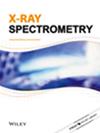高盐度样品中痕量元素的全反射 X 射线荧光分析
IF 1.5
4区 物理与天体物理
Q3 SPECTROSCOPY
引用次数: 0
摘要
对高纯度化学品和环境相关样品进行可靠的痕量分析比以往任何时候都更加重要,这也促使了新型分析方法的开发。全反射 X 射线荧光 (TXRF) 分析是一种日益为人所知的方法,可用于测定环境和工业样品系统中低浓度水平的重金属。然而,该方法仍需优化,以获得快速、精确的结果,尤其是对于电池生产中使用的盐水或海水等高盐度样品。本研究在碳酸锂(Li2CO3)和人工海水(ASW)(分别含 1000 mg/L Li 和 24,000 mg/L NaCl)基质中分析了浓度范围在 0.1 至 1 mg/L 之间的钴 (Co)、铬 (Cr)、铜 (Cu)、铁 (Fe)、锰 (Mn)、镍 (Ni) 或锌 (Zn) 等多元素标准溶液,基质与分析物的比率高达 240,000:1 。为了用最少的时间(3)获得尽可能高的重复性(1)和信噪比(2),对不同的样品制备方法进行了比较。样品体积、干燥条件、时间、温度和添加剂浓度等各种参数均有不同。用相对标准偏差(RSD%)来衡量每个样品三次重复的可重复性。对于碳酸锂,所开发的方法制备时间仅为 2 分钟,测量时间为 500 秒,可获得远低于 5%的 RSD%,线性度高(R2 > 0.99),大多数元素的检测限(LOD)在 30 μg/L 至 60 μg/L 之间。海水分析可根据信噪比进行优化,使用内标(Ga)的 Kα 线进行评估,并发现使用干燥器可获得最佳结果。本文章由计算机程序翻译,如有差异,请以英文原文为准。
Total reflection x‐ray fluorescence analysis of trace elements in highly saline samples
The reliable trace analysis of high‐purity chemicals and environmentally relevant samples is more important than ever and has led to the development of novel analytical methods. Total reflection x‐ray fluorescence (TXRF) analysis is an increasingly known method for the determination of heavy metals at low concentration levels in environmental and industrial sample systems. However, there is still a need for optimization to obtain fast and precise results, especially for highly saline samples like brines and salts used in battery production or sea water. In this study, multi‐element standard solutions containing analytes like Co, Cr, Cu, Fe, Mn, Ni, or Zn in a concentration range between 0.1 and 1 mg/L were analyzed in the matrices lithium carbonate (Li2 CO3 ) and artificial seawater (ASW) containing 1000 mg/L Li and 24,000 mg/L NaCl, respectively, leading to matrix‐analyte ratios of up to 240,000:1. Different sample preparation methods were compared in order to achieve the highest possible repeatability (1) and signal‐to‐noise ratios (2) with the least amount of time (3). Various parameters such as sample volume, drying conditions, time, temperature and additive concentration were varied. The relative standard deviation (RSD%) was used as a measure of repeatability for three replicates per sample. For lithium carbonate, a method with a preparation time of only 2 min and a measurement time of 500 s could be developed, which allowed to obtain RSD% well below 5%, a high linearity (R 2 > 0.99) and limits of detection (LOD) in the range of 30 μg/L to 60 μg/L for most elements. Seawater analysis could be optimized with respect to signal‐to‐noise ratio, whereby the K α
求助全文
通过发布文献求助,成功后即可免费获取论文全文。
去求助
来源期刊

X-Ray Spectrometry
物理-光谱学
CiteScore
3.10
自引率
8.30%
发文量
38
审稿时长
6-12 weeks
期刊介绍:
X-Ray Spectrometry is devoted to the rapid publication of papers dealing with the theory and application of x-ray spectrometry using electron, x-ray photon, proton, γ and γ-x sources.
Covering advances in techniques, methods and equipment, this established journal provides the ideal platform for the discussion of more sophisticated X-ray analytical methods.
Both wavelength and energy dispersion systems are covered together with a range of data handling methods, from the most simple to very sophisticated software programs. Papers dealing with the application of x-ray spectrometric methods for structural analysis are also featured as well as applications papers covering a wide range of areas such as environmental analysis and monitoring, art and archaelogical studies, mineralogy, forensics, geology, surface science and materials analysis, biomedical and pharmaceutical applications.
 求助内容:
求助内容: 应助结果提醒方式:
应助结果提醒方式:


